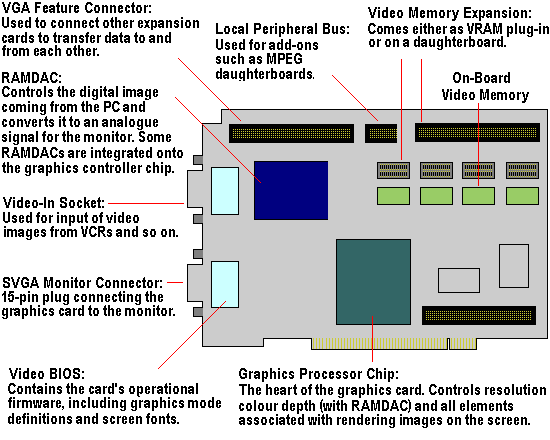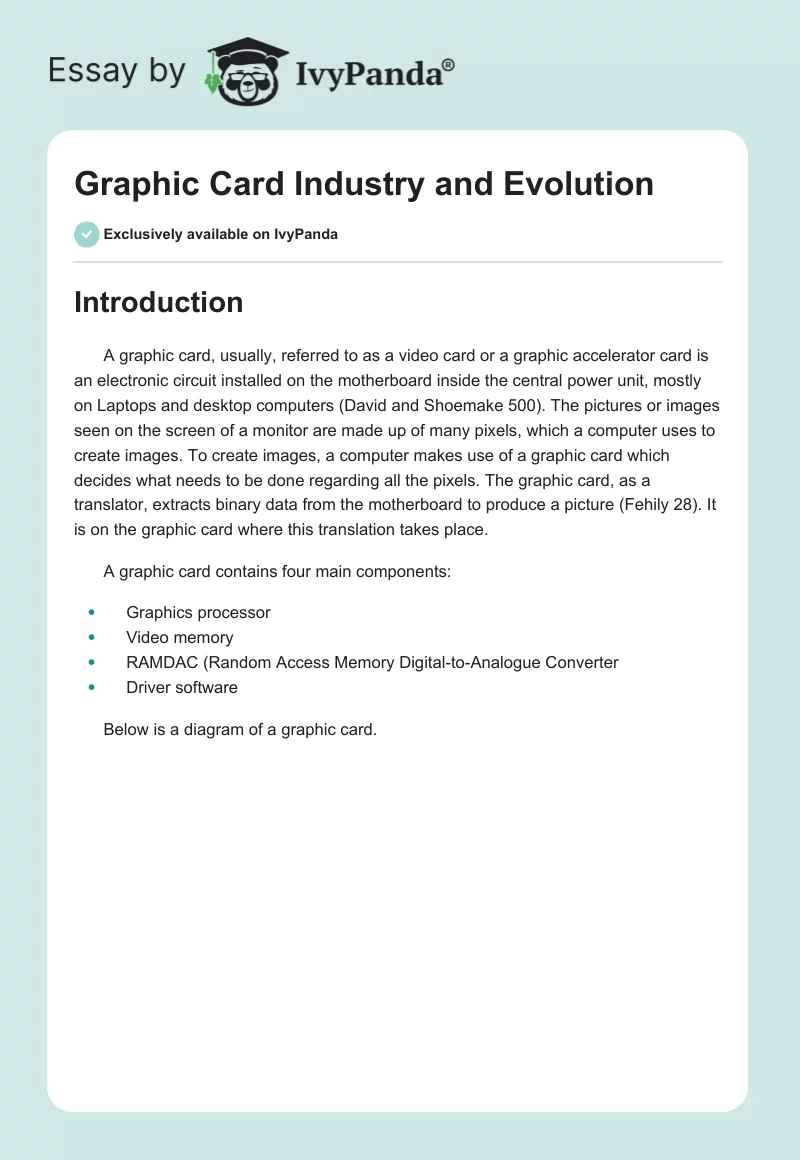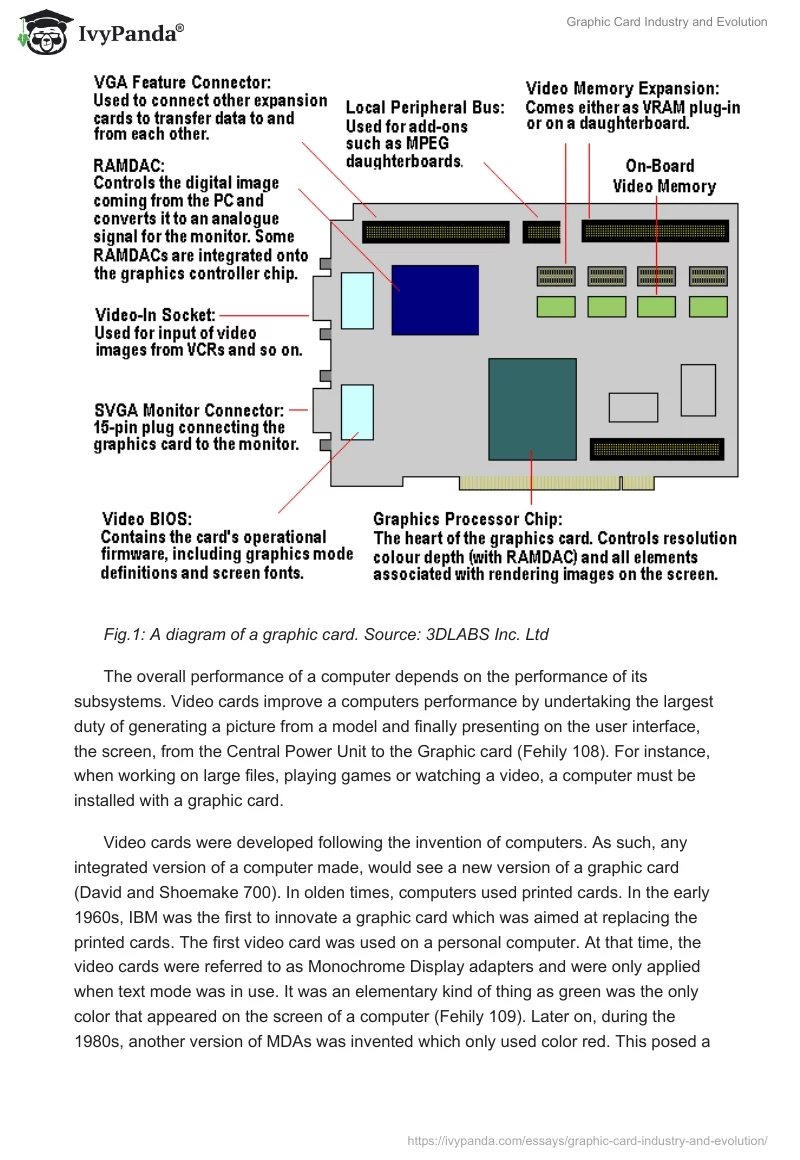Introduction
A graphic card, usually, referred to as a video card or a graphic accelerator card is an electronic circuit installed on the motherboard inside the central power unit, mostly on Laptops and desktop computers (David and Shoemake 500). The pictures or images seen on the screen of a monitor are made up of many pixels, which a computer uses to create images. To create images, a computer makes use of a graphic card which decides what needs to be done regarding all the pixels. The graphic card, as a translator, extracts binary data from the motherboard to produce a picture (Fehily 28). It is on the graphic card where this translation takes place.
A graphic card contains four main components:
- Graphics processor
- Video memory
- RAMDAC (Random Access Memory Digital-to-Analogue Converter
- Driver software
Below is a diagram of a graphic card.

The overall performance of a computer depends on the performance of its subsystems. Video cards improve a computers performance by undertaking the largest duty of generating a picture from a model and finally presenting on the user interface, the screen, from the Central Power Unit to the Graphic card (Fehily 108). For instance, when working on large files, playing games or watching a video, a computer must be installed with a graphic card.
Video cards were developed following the invention of computers. As such, any integrated version of a computer made, would see a new version of a graphic card (David and Shoemake 700). In olden times, computers used printed cards. In the early 1960s, IBM was the first to innovate a graphic card which was aimed at replacing the printed cards. The first video card was used on a personal computer. At that time, the video cards were referred to as Monochrome Display adapters and were only applied when text mode was in use. It was an elementary kind of thing as green was the only color that appeared on the screen of a computer (Fehily 109). Later on, during the 1980s, another version of MDAs was invented which only used color red. This posed a problem since no pictures would appear to exhibit both colors. It was either green or red. Later in 1980s, several improved graphic cards were made.
Another generation of MDAs was introduced in the 1990’s and this was referred to as Video Graphic Adapter, today known as VGA. This had the ability of displaying images with different colors and would even show an image at a better resolution (Thorn 241). It was due to this innovation that many companies came into existence. A good example of a company which came into being as a result of the invention of the VGA is the Cirrus Logic.
The invention of another version of VGA, however, did not take long. Super VGA was more superior and upgraded compared to the other versions. It had 256 colors and an internal memory of 2 mega bytes (Thorn 247).
Video card development did not stop at this point and in the mid 1990s, another generation was introduced. This came in the form of 2D and 3D. 2D and 3D video cards showed graphics that were multi dimensional. The most recent innovation was the Voodoo. This was, and remains to be, the greatest innovation of all times in regards to graphic cards. It helped software developers come up with in-depth graphics with the help of a chip (Thorn 205).
Discussion
Graphic cards have different internal memories and different computer applications require different memories. Those that involve low resolutions are executed using low memory graphic cards (David and Shoemake 426). A computer game usually entails high-resolution graphics and hence, using a low memory graphic card would make a game incompatible with the computer system. Therefore, to run a personal computer game, one must use a graphic card whose memory exceeds 512 megabytes. A graphic card eases the practice of playing computer. A computer system that runs a 3D title, which is above 90 frames per second, has GPU horsepower that is capacious enough and hence one could use for the improvement of the game’s image quality (Parsons and 12).
Significance of graphic card industry
Invention of graphic cards has had a terrific significance in the life of an individual and to the society. In fact, due to its application on computers, it has led to improved lifestyles, both in social and economic perspectives (Fehily 48). The graphic card industry has led to the establishment of entities. Individuals view graphic cards as viable opportunities of starting ventures. These cards have helped companies in the entertainment industry to flourish. An example of such a company is EA GAMES. This gaming company is concerned with producing personal computers and playing station games. The initiators of this company took advantage of the innovation of graphic cards and established a gaming company (Parsons and 22). Graphic cards have not only boosted the entertainment industry, but have also employed people and, therefore, helping individuals to raise their standards of living.
It is argued that, without entertainment, human life can be immensely uninteresting. People buy visual devices such as personal computers, DVD players and television sets to be entertained. These electronic devices help improve the social life of an individual by breaking boredom (Cook and Keromytis 641). Pictures and the flow of events in the visual devices leave the person happy and entertained. As such, this is made possible by the presence of graphic cards in those devices. There would have been none if a graphic card were not in existence.
To a greater insight, graphic cards are perceived as helpful in alleviating misdemeanors of social life. An idle person is the source of evil deeds in the society and visual electronics make many people busy (Bjelland 192). Watching movies and playing computer games is vital and is a good source of entertainment. As such, one becomes glued to the screen, and thus he or she cannot think of evil deeds such as activities that cause problems to people in the society. Therefore, to some extent, graphic cards help improve security in a society and as a result, community members become safe (Cook and Keromytis 402).
Graphic cards can be attributed to the establishment of businesses. Ideas of starting entertainment spots such as play stations and cinemas arise due to visual capability of computers and other electronic devices. As such, graphic cards have proven to be social devices and entertainment spots where people, not only game but also interact. The best example is where graphic cards make people, unknown to each other, to meet and interact (Bjelland 92). They come to know each other and, that becomes the onset of a friendship. Consequently, for those using the cards to play games, it enhances their social life through knowing each other. The owners of the entertainment joints encounter diverse characters and this, not only enhances their social lives but also their economic welfare becomes proficient.
Commercial entertainment spots are recognized as elements that make up a country’s business unit. All commercial undertakings are governed by state policies such as tax policies and this helps in regulating the businesses. The entertainment spots submit monthly tax and, when the government pools these resources, a revenue base is established. As a result, different government engineered projects can be started from funds obtained from entertainment businesses associated with graphic cards. The projects are as a result, beneficial to the society. For instance, a government-engineered project includes the construction of modern roads which are beneficial to citizens in such a way that transport becomes easier and products reach a greater geographical area than it would have been if such a project was not initiated.It also becomes easier to transport agricultural products to various markets (Cook and Keromytis 511).
The graphic industry has also given rise to creativity and innovativeness when it comes to electronic dependent arts. By use of graphic cards, it is easier to come up with different aspects of art that are of high quality. Graphic cards installed in computers make it possible for cartoons are designed, and these are entertaining to the society. A person can create ideas in his mind which through the use of graphic cards can be translated into an observable piece of art.
The existence of graphic cards has led to improvements in the mobile phone industry. Old handsets were elementary and did not have pictures. The mobile industry has come up with graphic cards that are compatible with handsets and mobile phones can now display pictures and this enables people to watch visual clips (Bjelland 225). This, in turn, improves the performance of the handset and the user enjoys having the handset. Today, due to inbuilt graphic cards in mobile handsets, one can input and view videos as well as access and see pictures.
Graphic Cards are also pertinent to the advertisement industry. Advertisements are mostly used to promote events as well as promoting products. They design attractive advertisements and pass them to the public through the media. It is through graphic cards that this is made possible. As a result, the advertisements attract customers and hence the overall sales of a business entity are increased. The same case applies to advertisements that are designed for other purposes other than business purposes.
Graphic cards have also helped increase security in the society. Closed circuit televisions have been installed on buildings for security reasons (Bjelland 190). They operate in such a way that they capture everything that takes place both outside and inside their locations. They do this by showing live pictures, which help in boosting security as any ill motive is easily detected and acted accordingly.
A graphic card helps improve the understanding capabilities of learners in educational institutions. These institutions employ pictures from computers and other devices to aid or to act as teaching aids. It is said that when you learn while incorporating pictures as a learning strategy, it is easier to understand than just reading the theory. It is, therefore, due to graphic cards that pictures and videos are produced. Teachers and lecturers use the relevant ones as a way of helping impart knowledge on the students. Consequently, the students will comprehend what is being expressed, and this will last in their minds for a long time. Graphic cards, therefore, help students to remember what they learn (Bjelland 92).
Graphic cards are, however, associated with several shortcomings in the society. They are seen as chief objects that have critical influence to individuals living in the society. Graphic cards are the source of pictures seen in visual electronic devices and do not discriminate indecent or expedient contents. It is, therefore, through them that pornographic materials are produced. This has a negative influence to the individuals accessing such materials especially the young in the society.
Graphic cards encourage immorality (Null and Lobur 69). The youth after viewing immoral contents, start practicing what they see. Consequently, cases of irresponsible behaviors such as fornication and early pregnancies arise. Many people also suffer from infectious and dreadful diseases associated with sex.
The economic status of a country can be adversely affected if a large part of the population is unemployed. As depicted above, irresponsible behaviors arise resulting to layoffs in work places as well as deaths resulting from sex related diseases (Null and Lobur 326). This leads to increased unemployment levels in a country. Unemployment in any given country lowers the economic growth of a country. The deaths of people who are vital to the country, e.g. the young people, lead to loss in work forces. All these have a negative effect on a country’s economy. This argument rests on the issue of graphic cards and pornographic materials leading to economic degradation.
Computers, play stations, televisions, and other devices in which graphic cards are installed, make individuals to develop a tendency which later grows to addiction. Addiction is in itself a vice because, once a person becomes addicted, he or she forgets his responsibilities and the mind becomes unfocused. He or she becomes a social misfit (Null and Lobur 340). This is simply because he cannot get time for others because he is too much into the game. This follows a state of psychological illness.
Conclusion
Graphic cards are indispensable elements in the contemporary society. Through graphic cards, social and economic aspects of people have been improved, and as a result, the society has advanced. To reduce the adverse effects associated with the use of these devices on computers, different measures can be put forward. Such measures include educating the youth on the pros and cons of graphic cards and how they should use them to avoid instances of irresponsibility. This ensures that the individuals accessing materials produced as a result of graphic cards do not suffer the negative effects associated with them. It is, however, clear that graphic cards have made human life interesting through entertainment services. The invention of these cards has had a terrific significance in the life of individuals and to the society as a whole. In fact, its application on computers, has led to improved lifestyles, both in social and economic perspectives.
Works Cited
3DLABS Inc. Ltd. Legacy Graphic Cards. 2006. Web.
Bjelland, Harley, Using online scientific & engineering databases. Massachusetts: Morgan Kaufmann, 1992. Print
Cook, Debra and Keromytis, Angelos. Exploiting Graphics Cards for Security. Connecticut: Cengage Learning. 2010. Print.
David, Eberly and Shoemake, Ken. Game Physics. Massachusetts: Morgan Kaufmann, 2004. Print.
Fehily, Chris. Microsoft Windows Vista. California: Peach pit Press, 2008, Print.
Nul, Linda and Lobur, Julia. The essentials of computer organization and architecture. Massachusetts: Jones & Bartlett Learning, 2006. Print.
Thorn, Allan. DirectX 9 Graphics: The Definitive Guide to Direct3D. Texas: Wordware publishing Inc, 2005. Print.


